I have come around many users who have lost administrator rights on their Windows 11/10/8/7 PCs, and thus they were not able to manipulate their system or make changes to it. One common thing I found regarding the issue is that the users who have lost their administrator rights have only a single account on their system, which was, of course, the administrator account. As a result of losing the admin rights, you may have issues in using Windows Apps, making new or modifying Windows configuration settings in Control Panel, using Snap-ins, and several other problems on your system.
It thus becomes imperative for us to get the administrator privileges back anyhow if we want to run the system without road-blocks. But how do you get back these privileges since for every operation you have to carry out, requires the administrative rights itself, which we have lost, unfortunately? While performing a Refresh or Reset will fix the problem, you may want to try out our suggestion first and see if it helps you.
Lost Administrator Rights in Windows 11/10
1. Press WinKey + Q, type user accounts, and click on the result.
Then select your User Account > Click Manage another account.
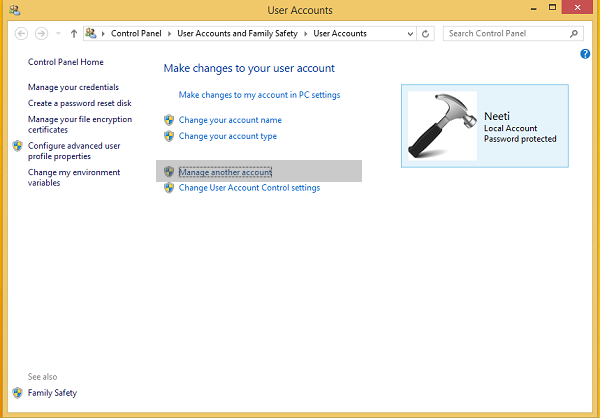
In the following window, click Add a user account option.
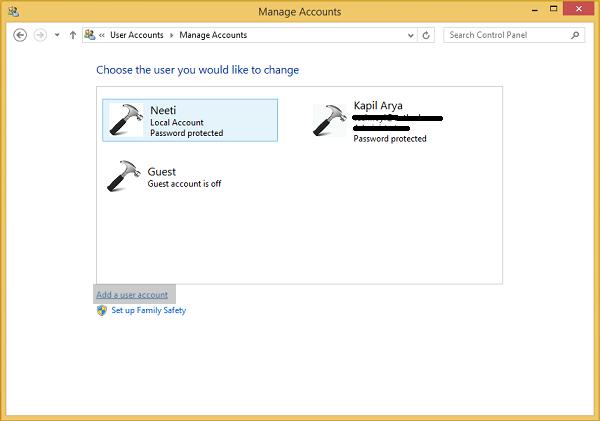
2. Now we have to create a local account user. So after clicking Add an account, click Sign in without a Microsoft account (Not recommended), then click Local account. Fill the details on the screen for adding a local account.
Click Finish when done.
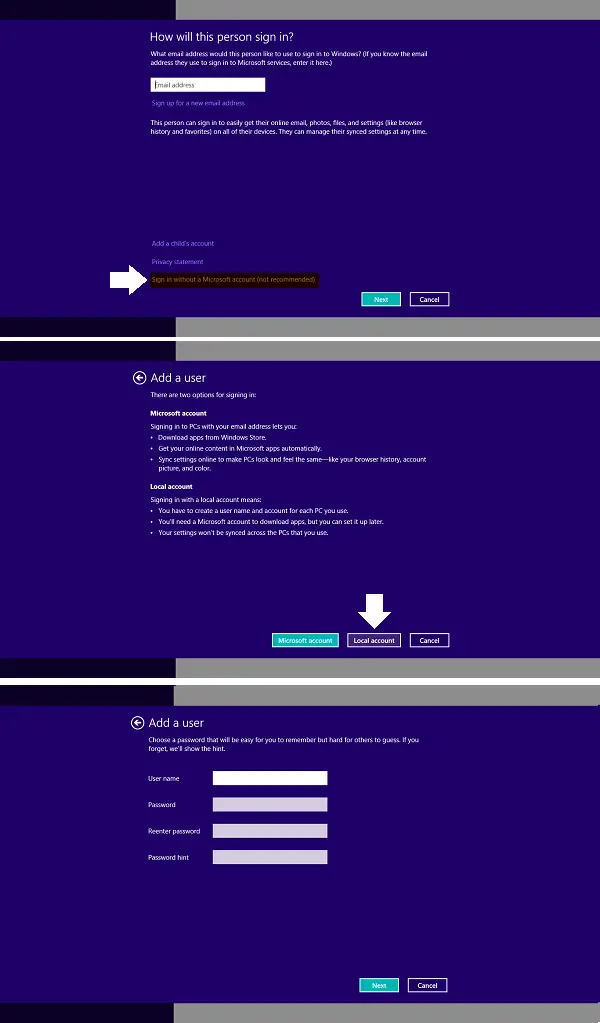
3. Press Windows Key + Q and type cmd, for the search results, click Command Prompt. Type the following the command and hit Enter key:
shutdown /r /o
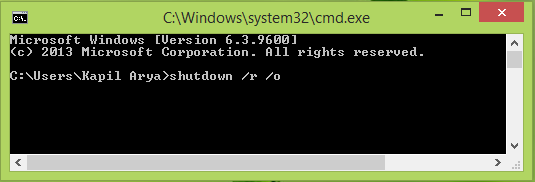
4. The previous step will result in your system booting into Safe Mode.
After getting into Safe Mode, press Windows Key + Q, type user accounts, and pick the same from results so appear. You would have now two accounts on your system; first your issued admin account and second the local account which you’ve created in step 2. Select the local account.
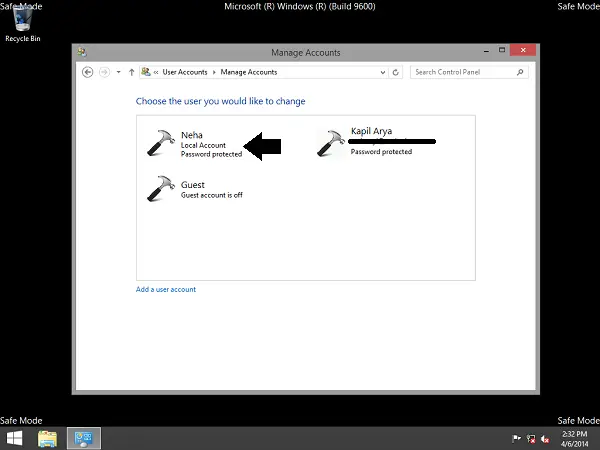
Now click Change the account type link in the following window:
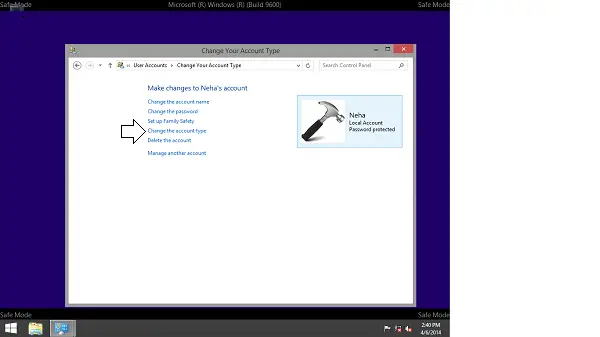
Moving on, change the account status from Standard to Administrator. Click Change Account Type.
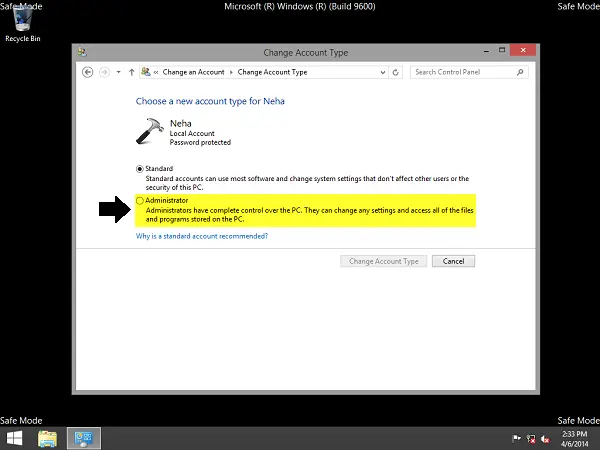
In this way, the new local account we’ve created has been changed to Administrator. Now you can restart your machine and log in to this account with administrator rights. Since you have administrative privileges now; so you can backup your documents from the old administrator account.
Finally, delete the old admin account and switch to Microsoft account to synchronize your settings with a new administrative account. Your system will now act normally with full admin rights in your hand.
Additional thoughts by Anand Khanse, Admin:
- In an elevated CMD execute this command and see –
net localgroup administrators <username> /add - See if you are able to activate the hidden super administrator account. Just in case you are able to, great – it will help you move forward. This is pretty useful if you find that you have locked yourself out of your main account by accident and you want a back door entry.
- Run your antivirus software first. Malware is known to sometimes block admin privileges.
- Try using Clean Boot. If this makes the problem go away, see if you can identify the culprit.
- If it does not help, you could boot into Recovery using Windows DVD or the Recovery partition and run System Restore to restore your computer to a prior point.
- In the case of domain computers, check with your system administrator, if it has applied any new restrictions.
- This policy setting can be used by Domain Administrators to ensure that only select authorized users are allowed to become members of groups like, say, the Administrators group: Computer Configuration > Windows Settings > Security Settings > Restricted Groups.
Vasudev G, adds:
You can also try to use the iCacls command and see if it helps. This command-line utility can be used to modify security descriptors and NTFS file system permissions.
Press the Shift key and the Power button to restart your Windows PC. You will boot Advanced Menu options. Here click > Troubleshooting > Command prompt. In the CMD window which opens, type the following command to reset permissions.
cd /d c:\ icacls * /T /Q /C /RESET
If nothing helps, then you may want to consider a System Restore or Refresh or Reset option.
Hope something helps you.
Hi KapilArya,
I’m not too computer-savvy (and particularly not with Windows 8.1!)
I was trying to change the admin account from mine (with my microsoft password) to one that both my husband and I could access.
Anyway, in doing so, I changed all account types to “user” so there was no more “admin”.
Now, I can’t get back to the User Account page… I’m assuming it’s because now there’s no admin account so I can’t do the things admin can usually do.
I tried what you suggested above but didn’t get very far. Under “Accounts” there’s no option in either of our sign-in names of “Other accounts”.
Do you have any other suggestions or are we stuck reloading Windows?
Hope you can help!
^^ You must have listed your native account there. Try creating a new user account as directed above, and please let me know which step didn’t worked for you, I’ll be happy to help you!
Ok, how do I switch the new account to a Microsoft account? Can I just leave it and keep it as admin and use it only when I want to make any changes/
^^ You can switch the new admin account to MS account in the same way you do it for regular accounts. Switching to MS account is upto you :-)
Yesterday I changed my user account type from administrator to standard and now I cannot even run system restore. Please help. Thanks.
Same problem here, cannot do anything.
And I have no Other Accounts under Accounts :(
changed my administrator password in win 8.1( IT is Microsoft account
in which u have to enter ur email ) BUT when I am logged in as another
local user and try to install something it asks for administrative
password and when i enter the CORRECT PASSWORD It says wrong password or
username
I recovered my microsoft account and changed the password online
But when I try to login to that a/c it says U have to be online to login for FIRST time
NOW HOW THE FUCK I will be Online if I dont login to desktop
IS There anyway i can change or Reset my pass ??
^^ You can connect your system to nearby WiFi network at the time of login, so that Windows can verify your password for the first time. Once you logged in, next time still if you don’t have WiFi connection available, you will be able to login offline :)
I was unable to get a response from any of the options that have the adminstrator shield next to them. It doesn’t prompt for UAC, just does not respond. Any thoughts?
^^ Check if the UAC level is set to “always notify” level or not :)
I lost all administrator rights when upgrading to 8.1. I tried following this, but when I click on ‘add new account’ nothing happens. I then tried it in safe mode and still nothing happens.
Hey Kapil!
While trying something on a folder a ended up changing its security permissions and now even as an admin I am not able to see the contents of the folder, Please help.
So i did this and it worked!!, but then about 2 weeks later it came back, i’ve lost most admin rights even though it still says im admin, can anyone help me?
^^ Make sure it is not password protected or encrypted. If that’s the case, you’ll require credentials to unlock content for you.
^^ If there exists a system restore point created 2 weeks ago on your system, use it to restore. Have you tried the fix again?
i do not have a restore point from 2 weeks ago, only from when i first installed windows
could it be that im logged into my microsoft account?
After reading these comments I’m glad now that I wiped my drive and re- installed windows 7 professional
Hello I really need help I upgraded to windows 8.1 pro but I logged In as admin and I dont have access to my programs it says I need to be logged in as an administrator and I have no way of getting in because I get denied everywhere. I have tried commands and I get denied all other ways and I get denied so what can I do in this case I really need to access my design programs I can’t even access my avg tuneup or nothing. Please help …….also I have tried the method above I started it on safe mode but I cant get the part where it says
Windows Key + Q, type user accounts,
Nothing happens it just brings up the search button. I dont get it. Please help!
Hello I really need help I upgraded to windows 8.1 pro but I logged In as admin and I dont have access to my programs it says I need to be logged in as an administrator and I have no way of getting in because I get denied everywhere. I have tried commands and I get denied all other ways and I get denied so what can I do in this case I really need to access my design programs I can’t even access my avg tuneup or nothing. Please help …….also I have tried the method above I started it on safe mode but I cant get the part where it says
Windows Key + Q, type user accounts,
Nothing happens it just brings up the search button. I dont get it. Please help!
Hello, i’ve been having trouble getting into the default administrator account on my pc. My sister changed the password on my administrator account and forgot it, So i’m forced to be on a standard account I made for her. I know how to get on the default administrator account but windows 8.1 is new to me since I’m a long-term windows 7 user. It’s windows 8.1 and i’ve read many pages on how to do it, but there’s a problem. the page says to go to the bar on the right of the screen, > settings, > change pc settings > update and recovery > recovery > restart, then it says to go to troubleshoot > advanced options > startup settings and click restart, so I did that, and when it booted up, the default admin didn’t appear. So I had to boot back into normal mode. Anyone know why the default account isn’t showing?
^^ You can use the same restore point and logging in to Microsoft account has nothing to do with restoring system AFAIK :)
i redid the fix, and so far its working, im not logged into microsoft atm, testing if it is the cause of the lost of admin rights
Under “Accounts” there’s no option in either of our sign-in names of “Other accounts”.
the problem started again, lost admin powers
As I recall the DOS then win 95,98,XP and finally Win 7 were much better that Win 8 which is a white elephant
What do you do if you dont have the option to add another account?
Not getting this at all. You have to have administrator rights to create a new account…..if I had administrator rights and password, I wouldn’t even need to create a new account. So what am I missing here?
How the heck do I create a new account if I don’t have administrator privileges? That’s my problem in a nutshell, I need to log in with administrator privileges to fix this computer and the user has lost or forgotten their administrator password. I don’t even have “Accounts” like in your screens, I have “Users”….so are we even running the same version of Windows? “Accounts” is probably something you see IF you are logged in as an administrator……the whole purpose of the article is for people that DONT have administrator rights, so any instructions that require administrator rights are just useless.
^^ We have re-updated the post, please check :)
Thank you for this info guide. I am stopped on the first step where it says, “Then select your User Account Click Manage another account.” I can’t do anything as it throws up a window that says to enter the admin password, but there is no place to enter the password, and the Yes button is greyed out. Guessing I need to boot into safe mode or something to remove the other accounts and only have an admin account. Windows 8 is a nightmare!
GOT IT!
—–
1.) Boot into safe mode. You can do this easiest by opening a
command prompt (start menu -> type ‘cmd’). And type “shutdown /r /o”.
2.) You computer will begin to restart but give you a set of
troubleshooting options. Choose Troubleshooting -> Advanced Options
-> Startup Settings.
2.5.) Press 4 to choose safe mode.
3.) After restarting and entering safe mode, switch users by going
to the start menu -> click your username -> and choose
Administrator.
4.) Windows will begin the first-time initialization for this account.
5.) Once logged in, open the command, windows key + R, then type “cmd”.
6.) Type “net user Administrator /active:yes” To set the admin account as “active”. It will now show up outside of safe mode.
7.) Reboot your machine and log in as the administrator again. You
can now add users and play with permissions etc. (The metro options are
not available in safe mode, hence the reboot).
How to remove your old ‘lost’ account and sync your new account with microsoft account.
1.) Create a new account via the users section from the control panel. Be sure to give yourself admin rights.
2.) Delete your old lost account by typing “net user
/del” into an administrator command prompt. You need to
know your old account name, good luck with this one.
3.) Go to your pc settings: Open the right-side context menu -> Settings -> “Change PC Settings”.
4.) Go to users tab -> Select “Switch to a Microsoft Account”.
——
From Nsparisi’s instructions, edited for what I did:
http://answers.microsoft.com/en-us/windows/forum/windows_8-security/how-do-i-gain-the-administrator-rights-on-the/98ea7298-7063-4189-9d0e-5b27a4e41314
^^ Isn’t your account is on Standard status since it has lost admin rights!
^^ Thanks for your inputs, hope it will useful for many :)
umm theres a problem, in order to MANAGE ANOTHER ACCOUNT you need admin rights so what should i do now?
Dude I cant manage accounts it said want changes to be made blah blah blah but I cant click yes and I only have 1 account on my computer and it be not admin so I cant press yes pls I cant do any thing helpp
HOW DO I DO DAT
Ikr same here I have no admin it is gone I have 1 account
I only have 1 account
^^ Press WinKey + Q, type UAC and pick User Account Control from results. Change the level to always notify/top.
same for me — everything leads back to a demand for an administrative login/password that is not recognized. GOD how I loathe MSFT. I hope the new guy fires everyone of those programmers.
Will this work if I forgot my administrator account password and only have access to guest account?
hey i have that problem but the thing is i cant do anything… i cant even click on manage user accounts because it asks for an administrator password but when it asks me theres no box for me to type and i cant click yes??? i need help please..
I can’t access anything on my computer including default programs, Control Panel, user accounts, nothin. I am completely blocked out and I am the only one that uses my computer. I have tried everything even command prompts. I can’t even system restore because all I get is. ” this operation has been cancelled due to restrictions in effect on this computer. Please contact your system administrator.”
So my question is how are we suppose to get past step two when step two gives you the contact system administrator warning? I like a commenter below am unable to get into any option with a shield. Attempted “Press WinKey + Q, type UAC and pick User Account Control from results. Change the level to always notify/top.” But got the system administrator block again.
How about a way to change your admin rights when you are having a startup error and you cant do shit because you have to be an admin -_-.
hi,
well i kinda gave up on my desktop until i found this page. wish i could use some of the assistance here.
my problem is that i think my system was hijacked and i couldnt do anything about it. i have tried reformatting and clean boot clear partition and stuffs i googled.
the main issue that i am currently facing is that my boot partition will always clone whatever disk or removables i plugged in. i have also tried with the bootsect /nt60 commands too which i dont fully understand. but at least i have a system to run. Once everything set up, its never been the same like before, it’s like theres another explorer in shadow and the remote assistance is always on. No matter how mnay times i ripped that ON button.
can anyone give me some guidance on how to save it?
sorry for the bad typing and language though..:)
hello
user account in my allredy add in administrators group but i still get error when i add a network printer error is “” unable to connect network printer . Access deny” have yu any solution
I was unable to change the account type because the administrator option was greyed out. Eventually I promoted my user to an administrator with a boot media named PCUnlocker Live CD and it worked great! Thank you anyway!
it won’t let me add a new account how do I get passed it?
Many people lost their administrative rights mainly because they forget their administrator password. In this case, I have a good solution to help those people. WINDOWS PASSWORD KEY will help them easily reset the lost admin passwords and allow them to regain access to their Windows 8 computer.
When I go onto User Accounts in the control panel, all I see is “Change User Account control setting” and Manage User Accounts” and clicking either of them asks me for the administrator password. What do I do now?
This falls at the first hurdle. When you click Manage Another Account, User Account control stops you and asks for an admin password – the very thing you don’t have.
I had to start in safe mode and then run “netplwiz” to enable administrator privileges on my account. It took forever, but I finally realized that the password to my hidden administrator account was blank. Can someone tell me why is it possible for me to remove all admistrators from my accounts?
It seems there’s more than one level of user/administrator … and the descriptions of said levels are not to be found in official documentation.
On my own Win 8.1 device, there were 3 “users”: Myself (under an assumed name, of course), “Guest” and “Administrator.” As Myself, I have some Administrator privileges. Unfortunately, Myself did not have sufficient privileges to make the fixes I need to fix.
For me (so far), creating a new Local Account with Admin privileges has worked just fine. Jury’s still out, ’cause I’m not yet done with all of the fixes.
It seems a lucrative e-book could be written about ALL of the Administrator hurdles that all too many users must face before they can use their machines.
(Ya know … in the past couple of days, I’ve spent more time in Command Prompt than I’ve done in the past 20 years. Back in the day, I played with DOS for fun. Windows 8.1 is nowhere near ready for prime time!)
Hi, Please I lost my admin password on my windows 8.1 and this admin access and microsoft access are the only users I have. I can access through the microsoft access. There is no option of other account coming up. I have tried all options above to reset my password but the user account control kept asking me for password confirmation of my default admin password which I can access. Can you assist please?
i was going to use your expertise to solve my problem, however, i was afraid what would happen to my old user account, so i did not use your suggestions. I use the other way, which is simple and no risk. I use the “back up to the previous system time” (not sure in english) it solve my problem. I still think you are very good in giving us all the details of solutions. thank you very much.
I removed my Administrators Account and i cant change my account type, i cant enable my Administrators Account, i cant make a another account,i cant change user account control settings, i cant open Command Prompt (Admin) ,its says ‘To continue type an Administrator password,then Click Yes’. But, i cant type a password and click yes. For now i am using Local Account/Guest Account pls help me!
hi,i don’t know very well but after i clicked on MANAGER ANOTHER ACCOUNT apear another window with UAC ,and don’t let me to click on YES only NO ,what can i do?
I am changing my local account to Administrator in Windows 8.1 but PC is not saving the settings. Pls help me out….
^^ You need to turn off guest account first, let me know if you can.
I have tried several time to off the guest account but the setting did not change the guest account to off.
so i tried to go into safe mode skipping the fist steps because their impossible wihout admin rights. it said i cannot log into saf mod withou a admin account. i do no see a way around this. please help!
i wont be i have 1.3 tb of data
Actually I may have the same I have two new hard drives unused of a terabyte each
I can’t even go further than “Manage User Accounts” because it needs admin password. However, There is no accounts under the “Insert Password” box. PLEASE HELP
Hi i follow the steps but then its still standard :(
I cant even see that!
please help me.i accidentally disable my admin account on windows 8 and i cant log in to that account because of that ..im now only using a standard or local account. please help me.. i have so many important files on that admin account.. i also cant make changes because of that… when i go to lusrmgr.msc.. i cant enable it. what should i do??? how do i enable it?? please help… i really apreciate ..
->->->->-> TO ALL WITH THIS PROBLEM <-<-<-<- go to the restart button, HOLD SHIFT and PRESS THE BUTTON in the same time
… 4) Choose Troubleshoot >> Advanced Options >> Startup Settings >> use F4 >> Restart, pressing F4 >> log in as … Administrator (usually no password is set, just press log in – otherwise you’ll need to find/remove the password first)
… 5) (see 9 too) As Administrator go to This PC (right click) >> Manage >> Local users and groups >> Users >> Administrator(right click) >> Properties >> tick “Account is disabled” >> OK
… 6) Even more, you can also go to (your personal account) >> Properties >> Member of >> Add >> (type “Administrators”) >> OK
… 7) (=6) You can do the same this way >> Local users and groups >> Groups >> Administrators >> (add you personal account’s name) >> OK
… 8) Restart and Enjoy !!!
PS:
… 9) (=5) you cannot use Command Prompt for changing if the Admin account is active or not without being logged in the Admin account !!!
I mean the command for enabling / disabling Admin account (in cmd – Command Prompt):
” net user administrator /active: yes ”
or: ” net user administrator /active: no ”
>> You need to be in the Admin account to change that >> … 5)
->->->->-> TO ALL WITH THIS PROBLEM <-<-<-<- go to the restart button, HOLD SHIFT and PRESS THE BUTTON in the same time
… 4) Choose Troubleshoot >> Advanced Options >> Startup Settings >> use F4 >> Restart, pressing F4 >> log in as … Administrator (usually no password is set, just press log in – otherwise you’ll need to find/remove the password first)
… 5) (see 9 too) As Administrator go to This PC (right click) >> Manage >> Local users and groups >> Users >> Administrator(right click) >> Properties >> tick “Account is disabled” >> OK
… 6) Even more, you can also go to (your personal account) >> Properties >> Member of >> Add >> (type “Administrators”) >> OK
… 7) (=6) You can do the same this way >> Local users and groups >> Groups >> Administrators >> (add you personal account’s name) >> OK
… 8) Restart and Enjoy !!!
PS:
… 9) (=5) you cannot use Command Prompt for changing if the Admin account is active or not without being logged in the Admin account !!!
I mean the command for enabling / disabling Admin account (in cmd – Command Prompt):
” net user administrator /active: yes ”
or: ” net user administrator /active: no ”
>> You need to be in the Admin account to change that >> … 5)
when i try to enter the UAC it asked me for the administrator password but no box for me to put in any password.
that wasn’t helpful in my case whenever i try to press the manage another account in user accounts i can’t , it requirs the administrator rights to do so like always whenever i try to open or modify a program ,the pc always asks for administrator rights
Hello sir , after i instaling windows 10 insider program on my laptop stops working, i can seen only black screen and cursur.
I tried to install the windows 7 by using dvd but can not respond for anything , so what can i do now , please help me.
how does that work when you have to have an administrator password to create the new account…. according to the very first screenshot?
I did the refresh option because I kept getting a temporary profile when I login, now, I am stuck in a screen that says administrator which when selected says the account has been disabled and to contact the system administrator. There are no other buttons on the screen, not even the shutdown button. I don’t know what to do to be able to login. Can you help? Thank you.
i cant make another account because im not an administrator
hi
My computer user account how to restore?
i tried this and it did not work my computer is really f****d and there is only 1 account and it not a admin
Yup me too
Can anyone help us
Hi! I can’t open manage accounts because I don’t have any administrator rights. I’m stuck on guest account but I want admin rights. But everything they show me to do need admin rights, can you help me?
I got some problems with my laptop.
I only got 1 user account. 1 day I switch on my laptop and it is not my desktop anymore. All my files on previous desktop were missing. Then I open ‘my computer’ > desktop file and put back all the files on the new desktop. Then I switch off my laptop. Next day I switch on back, it turns to my original desktop and the files that i’ve move to the new desktop last day were gone. I can’t find the last day user account to find all my files.
Pls help me bringing back all the files.
Thankyou very much i’ve been having this problem for months ?
I recognize that windows 8.1 is not your fault. I am so frustrated. It says that I have administrator rights but I don’t really have administrator rights and there are 2 places that it can be changed. In one place I can change the rights of the original account and the new account I added as you explained above (change PC settings/accounts) but from the control panel and User Accounts I can not change the rights. In the control panel User accounts they do not have admin rights and I can not change it. Also I noticed in your screen shots you don’t have the ability to change the rights to admin either. “Change account type” is greyed out and can not be clicked. Also when I did the restart in safe mode I don’t think it really came up in safe mode. There was a screen that came up before shut down that I didn’t know what to do with and I think it didn’t really go to safe mode. And which account are you supposed to log into when it does restart? Does that matter?
I cannot make a new account without first having the password for my admin account, I have my computer set up so that my kids cannot change or touch anything, so I cannot do anything on any other account without knowing the password I forgot
How can I go about fixing this? Your above steps will not work every time I try it prompts me to sign into my admin account that I cannot access
Hi kapil
my computer has windows 10
and if i try to delete any app the user account control pop ups and it does not allow to click yes.
not anywhere have i seen the fact that on an admin password the password is on the board… so if you format and do a fresh install it still wants the password. the password is on a chip. ep rom ….. so you need an ep rom reader……of course i could be mistaken but hey a person i know says he made no password and it still wants one. he can use the laptop but needs administrative rights to change settings and like add a dvd burner……i told the guy to use hiren’s boot cd but i forgot my buddy ordered a stack of laptops from a school with admin passwords and then he got the ep rom reader but never used it so he still has a stack of laptops. you wondering why i am posting is just because i pretty sure the password is on your board. otherwise you could get software and just hack your computer….. the reason for password hidden in the board is because lots of thieves are out there. i am calling nobody names, just saying….it is really odd no mention of ep rom reader. so i am wondering am i right or wrong is all……i feel kinda bad now i told that guy i would find a way to get his laptop admin rights…. i hope it is a bug then i guess there is a workaround somewhere…..
Issue: Local (and only) account on Windows 10 has no admin rights. Says “Local Account, Guest Account”. I cannot establish any new accounts or change priviledges as there is no admin capabilities. How do I restore the existing account to admin or create a new account with admin rights?
Thanks!
FINALLY ! ! ! AFTER 4 months of being unable to DO anything after (stupidly) changing my administrator account to Local User…. This finally worked for me. I booted into Safe Mode, and chose the anonymous Administrator as the log on. I couldn’t do much, but I COULD change my Local User account to an Administrator Account. YES! I restarted, as normal, and TA-DA… I am once again Administrator, and can update my programs, and do everything I need to do. Thank you BOJIDAR. Just boot into Safe Mode, use the anonymous Administrator as the Log-On, and change/create/repair your hapless plain user account.
without administrator rights, as you said in the very beginning, you cannot access anything. That means no command prompt ADMIN and you can’t use anything that has an ADMIN icon next to it. Did you try creating your own account without having admin privileges? I don’t effing get it.
when i try to add a local account it fails because i don’t have the rights(0x80070005)
Hi All , i have Problem on administrator i deleted my administrator account on “netplwiz”
and i cant open anything as administrator And i cant change my account type because need administrator :( Pls someone hlep me
My problem began when I activated the Turbo mode of AVG PC Tune-up.
Dear Kapil
Where you show to click on ” Manage another account ” it says I need an administrators password to access it, but there is no administrator, so all I could click is No or the X. Please help
hello,
i have lost my administrator account and i’m using my local account. i tried the above solution you provided,but when i click on to manage another account,it is admin-locked and the ‘yes’ button is disabled. i couldn’t even access the hidden admin account by cmd wherein the same thing appears. kindly help ! TIA :)
A nice option, though there is no safe mode available in Win10, rebooting to the command prompt is within a separate windows environment, completely different users to the main pc. This instruction is not possible as a result.
How to bot into Safe Mode in Windows 10: https://www.thewindowsclub.com/boot-windows-10-in-safe-mode
It didn’t help to solve my problem on my laptop, I lost my admin account and not able to access for admin. anyone please????
Can not understand why Microsoft made so hard to get to safe mode. Windows 10 is worse than vista. I really hope someone makes a different os I am glad they got hit for back taxes. Maybe they can sell this crap to the people that you can not understand on support. I bought it in USA speak English. So far lost tons of my memories web cams 4 hard drives 5 motherboards. Used to love my PC those days are gone I think they are Democrats want suck every penny,out of me.
Apparently my Windows 8.1 operating system has been hijacked. I can not
Access any Admin privileges (although it shows me as a (Guest/Local/Admin) account.
It does NOT show the built in Admin account (only shows 1 standard account and also my account, a guest account [that falsely says it is password protected and a admin] both are untrue.
My laptop definitely 100% has been been hijacked (either by a very difficult form of Malware and/or a Human [due to the level of sophistication] I believe it was/is a Human attack.)
Things I’ve (unsuccessfully) tried.
1) Safe Mode system – refresh or reset. (won’t allow either due to NO admin rights) – it said “the system only shows “admin” accounts that PREVIOUSLY HAD signed into this PC – does not [currently] show or include any standard user or domain accounts?
2) net user Administrator /active: yes (says error 5 / access denied)
3) (right click – on THIS PC) properties… no “local/user groups” is show or available to change any of their admin privileges.
4) Tried to open a NEW local standard account (so I can use it to transfer (my so-called admin privileges to it) but it will not allow me to make either a new Microsoft or a new local Windows user account.
5) Can not go to PC SETTINGS and change “account types” either, to change who has the administrator rights.
BOTTOM LINE: This Hijack has my system in a TOTAL locked down – every way possible – it is very sophisticated and has managed to BLOCK every single option available to recover full administrative rights.
If there is anyone who KNOWS THEIR SH*T and wants a challnge – PLEASE help me BEAT this and get MY computer back!! Thanks all.
HELP!!
Apparently my Windows 8.1 operating system has been hijacked. I can not
Access any Admin privileges (although it shows me as a (Guest/Local/Admin) account.
It does NOT show the built in Admin account (only shows 1 standard account and also my account, a guest account [that falsely says it is password protected and a admin] both are untrue.
My laptop definitely 100% has been been hijacked (either by a very difficult form of Malware and/or a Human [due to the level of sophistication] I believe it was/is a Human attack.)
Things I’ve (unsuccessfully) tried.
1) Safe Mode system – refresh or reset. (won’t allow either due to NO admin rights) – it said “the system only shows “admin” accounts that PREVIOUSLY HAD signed into this PC – does not [currently] show or include any standard user or domain accounts?
2) net user Administrator /active: yes (says error 5 / access denied)
3) (right click – on THIS PC) properties… no “local/user groups” is show or available to change any of their admin privileges.
4) Tried to open a NEW local standard account (so I can use it to transfer (my so-called admin privileges to it) but it will not allow me to make either a new Microsoft or a new local Windows user account.
5) Can not go to PC SETTINGS and change “account types” either, to change who has the administrator rights.
BOTTOM LINE: This Hijack has my system in a TOTAL locked down – every way possible – it is very sophisticated and has managed to BLOCK every single option available to recover full administrative rights.
If there is anyone who KNOWS THEIR SH*T and wants a challnge – PLEASE help me BEAT this and get MY computer back!! Thanks all.